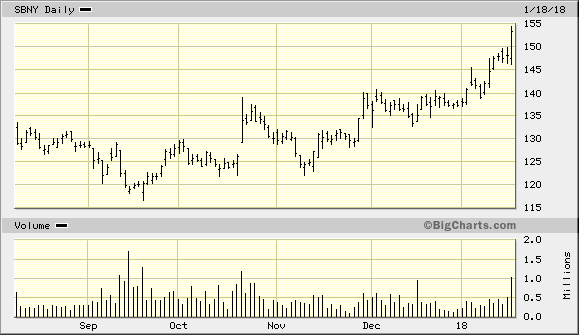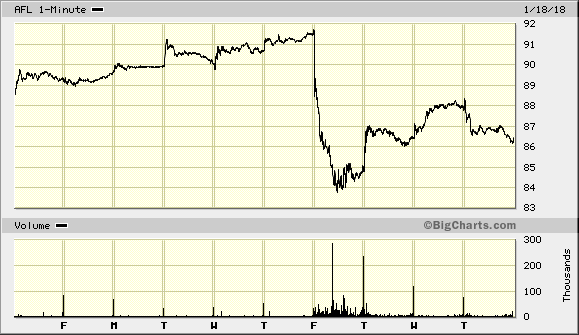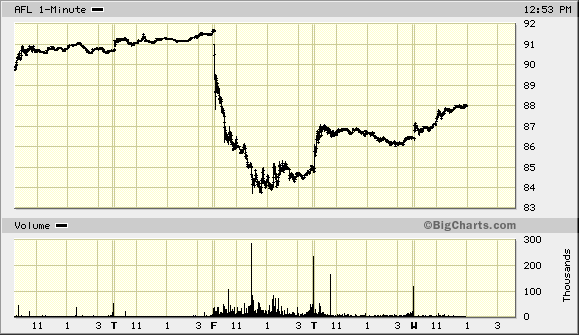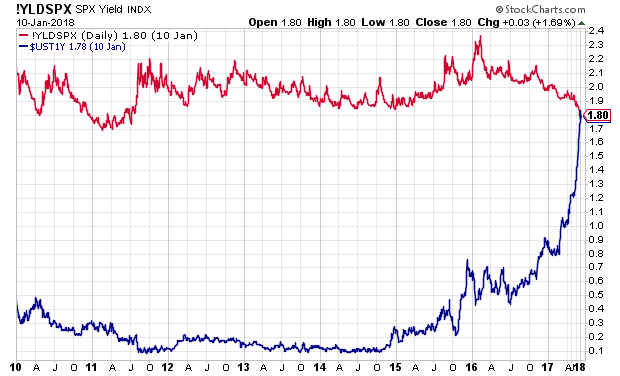Archive for January, 2018
-
Morgan Housel on What Other Industries Teach Us About Investing
Eddy Elfenbein, January 20th, 2018 at 4:24 pm -
CWS Market Review – January 19, 2018
Eddy Elfenbein, January 19th, 2018 at 7:08 am“Patterns are the fool’s gold of financial markets” – Benoit Mandelbrot
Earnings season has arrived. This is Judgment Day for Wall Street. You can have a great business plan, happy customers, and the best swag in the Valley, but if your numbers ain’t good, Lord help you.
Remember that earnings season is all about expectations, so it’s not so important to do well. Instead, you have to do better than everybody else was expecting you’d do. This, of course, means that people are expecting you to do better than what everybody thinks everybody else (but them) is expecting. Earnings season is basically a giant game of Twister. That’s worth $30 trillion.
I’m happy to say that our first earnings report this season was a good one. Signature Bank easily beat expectations, and the shares rose nicely on Thursday. Since its September low, Signature is up more than 31% for us. I’ll go over the earnings report in a bit. I’ll also preview upcoming earnings reports from Alliance Data Systems and Sherwin-Williams. Plus I’ll discuss an ugly hit-piece on AFLAC. But first, let’s look at the 20-cent earnings beat from Signature Bank.
Signature Bank Rises to Seven-Month High
On Thursday morning, Signature Bank (SBNY) reported adjusted Q4 earnings of $2.43 per share which was well above Wall Street’s estimate of $2.23 per share. I call the earnings “adjusted” because the bank took a charge last quarter due to their lousy business in medallion loans.
Let’s dig into some numbers. Last year’s SBNY’s total assets rose by 10.4% to reach $43.12 billion, and deposits rose by 5% to $1.58 billion. That’s quite good. For the year, Signature made $8.91 per share.
“2017 was a year during which our highly successful, single-point-of-contact business model further distinguished Signature Bank in an exceedingly competitive marketplace. We continued to attract quality business relationships as evidenced by the growth in both our core deposits and loans. Notwithstanding our challenges in the taxi-medallion business, we were able to achieve a double-digit return on equity,” explained Joseph J. DePaolo, President and Chief Executive Officer.
“Now with tax legislation becoming law and the positive effect we believe it will have on future earnings and capital, we look forward to the $50 billion SIFI threshold potentially moving higher, to at least $100 billion. This will allow the Bank to slow down the pace of expense growth. Realistically, Signature Bank, with its uncomplicated and straightforward balance sheet, should not be subject to the same standards as a truly complex, systemically important trillion-dollar financial institution. We welcome 2018 as we plan to strengthen our foundation by making major investments in our loan operation and origination systems, payments-architecture platform and new foreign-exchange system. We also will look to expand our geographic presence in areas where we have significant client synergies, such as the West Coast, after we successfully tested the waters in 2017 with the appointment of a team and the opening of our new accommodation office in San Francisco,” he concluded.
For Q4, Signature’s “net-interest margin on a tax-equivalent basis” bumped up to 3.07% from 3.05% in Q3. Except for the medallion mess (which is being addressed), SBNY is doing quite well. For Q4, their provision for loan losses was $41.7 million. That’s up 88% from last year. Thank you, medallions.
When looking at banks, there’s a key metric to watch: the “efficiency ratio.” It’s a bank’s overhead as a percent of revenue. The lower this number, the better. Signature defines its efficiency ratio as net interest expense divided by total income. As a general rule, anything below 50% is considered good. For Signature, the efficiency ratio was 33.5% last quarter. That’s really good, and it’s actually up from a year ago when it was 31.25%.
Traders were pleased by the report as shares of SBNY gained 3.6% on Thursday to reach a seven-month high. Signature has been rebounding nicely from a tough time during much of 2017. The stock is up more than 31% from its September low. This week, I’m raising my Buy Below on Signature to $160 per share.
Negative Article Knocks down AFLAC
Last Friday, shares of AFLAC (AFL) got nailed for a 7.4% loss after The Intercept ran a very negative article on them. The Intercept alleged:
The insurance firm Aflac has exploited workers, manipulated its accounting, and deceived shareholders and customers, according to nine former employees. This article is based on interviews with multiple current and former employees, as well as three previously unreported lawsuits.
The allegations contained in the lawsuits involve nearly every aspect of Aflac’s business and have already led to a series of investigations by state and federal regulators. But though Aflac’s top management and board of directors have known about the claims for over a year, they have not disclosed anything to shareholders in public filings with the Securities and Exchange Commission beyond generalities about unnamed pending lawsuits that they say they expect will not hurt the company’s bottom line.
The allegations, if true, are very disappointing. However, nothing I’ve seen so far has me concerned for AFLAC’s future. Of course, I’m hardly an independent observer. I’ve admired the company for years. Also, The Intercept has a political bent to its reporting, so I’m reading this with my eyes open, but most of what I’ve read so far is what I’d call the unseemly byproduct of running a large and profitable enterprise.
In the movie Raising Arizona, the police ask Nathan Arizona, Sr., if he has any disgruntled employees. He answers, “Hell, they’re all disgruntled. I ain’t running no damn daisy farm.”
The sales jobs at AFLAC are described as very tough and demanding. That’s not a surprise. Perhaps AFLAC is guilty of making the jobs seem better than they truly are, but that’s a long way from an Enron-type scam. It’s not difficult for them to revamp their recruitment process.
Any big company will have lawsuits brought against them. If you only read what the lawyers have to say, without any explanation from the company, the picture can look quite ugly. That’s what lawyers do. At one point, The Intercept compared working at AFLAC to being a sharecropper. That’s absurd.
Most of what’s alleged can be explained by saying that AFLAC plays to win in a tough business. The company has 10,000 full-time employees, and they do more than $20 billion in annual revenue. If you talk to all the former employees of any firm, the most disaffected can surely share some unpleasant stories.
To their credit, AFLAC quickly responded with a press release. Here’s the key bit:
Recent media stories regarding AFLAC contain false allegations made by a very small group of independent contractors. AFLAC intends to aggressively fight these allegations beginning with filing for their dismissal. The unfounded articles allege claims including insider trading, fraudulent sales and financial manipulation. The company has investigated these claims and found them to be without merit.
The Intercept says this is the first of a series. So far, I’m not exactly overwhelmed by the allegations. Fortunately, shares of AFL regained a lot of lost ground this week. At one point on Thursday, AFL was more than 5.5% above its low from the previous Friday. Don’t let this article scare you. AFLAC will report earnings again on January 31.
Earnings Next Week from Alliance Data and Sherwin-Williams
You can see our complete Q4 Buy List Earnings Calendar here. We have two more reports coming out next week. Both Alliance Data Systems (ADS) and Sherwin-Williams (SHW) are due to report on Thursday, January 25.
Three months ago, Sherwin had a very good earnings report, and the paint folks raised guidance. For Q3, SHW made $4.75 per share which was eight cents better than estimates. Their EBITDA from continuing ops rose 9.6% to $1.70 billion. The company estimated that the hurricanes dinged them for about 27 cents per share.
For Q4, Sherwin sees earnings ranging between $1.97 and $2.27 per share. Adding back 98 cents in acquisition costs, that comes to $2.95 to $3.25 per share. That works out to full-year 2017 earnings of $14.85 to $15.15 per share.
In October, Alliance Data System reported Q3 earnings of $5.35 per share which easily beat Wall Street’s forecast of $5.04 per share. I was pleased to see ADS reiterate its guidance of $18.10 per share for this year and $21.50 per share for 2018. Since Thanksgiving, the shares have had an impressive run (+15%) and that includes an ugly drop earlier this week. The consensus on Wall Street is for Q4 earnings of $5 per share.
That’s all for now. Earnings season ramps up next week. There will be several big-name earnings reports. We’re also going to get the existing-home sales report on Wednesday. Then on Friday morning, we’ll see the durable-goods report and the big Q4 GDP report. This has a chance of being the best GDP report in years. Be sure to keep checking the blog for daily updates. I’ll have more market analysis for you in the next issue of CWS Market Review!
– Eddy
Syndication Partners
I’ve recently teamed up with the folks at Investors Alley to feature some of their content. I think they have really good stuff. Check it out!
3 High Yield REITs to Grow From Interest Rate Increases
Share values of real estate investment trust (REIT) companies have been dropping since the Fed announced its last Fed Funds Target Rate increase on December 13. The Fed started raising interest rates in quarter percent increments in December 2015. Each of the four rate increase announcements has been accompanied by a pull back in REIT values. These declines have been short-lived and can be viewed as buying opportunities.
2017 was an interesting year for the REIT sector. While most of the S&P market sectors had stellar returns for the year, REITs as a group returned just a positive 5.1%. In contrast, the S&P 500 gained 21.8%. With average REIT yields near 4%, the 5% total return gives the impression that REIT values did not do much in 2017.
The REIT sector last peaked in mid-December just after the last Fed rate increase. Since then REIT values are down by 6.5%. This is the time to pick up some high-quality REITs and watch the share values for signs that prices have bottomed for this cycle. It’s not possible to pick and exact bottom, but the good news is that some very high-quality REITs are now sporting very attractive yields.
3 Stocks Taking Off From Trump’s Tax Cuts
The cut in the U.S. corporate tax rate from 35% to 21% is supposed to do everything from juicing the U.S. economy to levels not seen in decades to enriching both shareholders and consumers alike. But the reality is likely to be quite different.
The first thing it will bring is a muddied fourth quarter earnings season for investors. A one-time tax on accumulated offshore earnings and revaluations of deferred taxes, based on the new rate, means a lot of potential charges and writeoffs for multinational companies. For firms that report only GAAP earnings, the headline impact on earnings could be quite large.
Investors should look through these one-off charges and focus on what the long-term effects will be on the companies they are invested in.
While many on Wall Street make proclamations about the benefits of the corporate tax cut for banks, I believe the sector still faces too many headwinds (like continuing low interest rates) for me to be interested in investing into banks. Instead, I’d rather focus on three other sectors – with still relatively low valuations – that should benefit from the changes in the tax law regarding U.S. corporations.
-
Morning News: January 19, 2018
Eddy Elfenbein, January 19th, 2018 at 7:03 amOil Halts Rally as IEA Warns U.S. Production Surge Looming
The U.K. and France Are Thumbing Their Noses at the U.S. Over Net Neutrality Repeal
U.S. Watchdog Outlines Issues With Bitcoin ETFs, Mutual Funds
Government Closing Near as GOP Bill at Brink: Shutdown Update
Amazon Chooses 20 Finalists for Second Headquarters
Apple Leads These Companies With Massive Overseas Cash Repatriation Tax Bills
SoftBank is Now the Largest Stakeholder in Uber as Deal Closes
Google Inks a Patent Deal with Tencent as it Explores Ways to Expand in China
United Airlines To Launch Premium Economy Cabins In 2018
IBM Slides as ‘Tax Headwind’ Hits 2018 Outlook After Long-Awaited Sales Win
HSBC to Pay $100 Million to End U.S. Currency-Rigging Probe
Executive Behind Facebook’s China Charm Campaign Is Out
Jeff Carter: Basic Economics and Basic Business
Howard Lindzon: No Turning Back…Fintech Fintech Fintech
Mark Hines: Are You Still On the Sidelines?
Be sure to follow me on Twitter.
-
Signature Bank Earns $2.43 per Share
Eddy Elfenbein, January 18th, 2018 at 1:03 pmOn Thursday morning, Signature Bank (SBNY) reported adjusted Q4 earnings of $2.43 per share which was well above Wall Street’s estimate of $2.23 per share. I call the earnings “adjusted” because the bank took a charge last quarter of $37 million due to their lousy medallion loan business.
Let’s dig into some numbers. Last year SBNY’s total assets rose by 10.4% to reach $43.12 billion, and deposits rose by 5% to $1.58 billion. That’s quite good. For the year, Signature made $8.91 per share.
“2017 was a year during which our highly successful, single point of contact business model further distinguished Signature Bank in an exceedingly competitive marketplace. We continued to attract quality business relationships as evidenced by the growth in both our core deposits and loans. Notwithstanding our challenges in the taxi medallion business, we were able to achieve a double-digit return on equity,” explained Joseph J. DePaolo, President and Chief Executive Officer.
“Now with tax legislation becoming law and the positive effect we believe it will have on future earnings and capital, we look forward to the $50 billion SIFI threshold potentially moving higher, to at least $100 billion. This will allow the Bank to slow down the pace of expense growth. Realistically, Signature Bank, with its uncomplicated and straight-forward balance sheet, should not be subject to the same standards as a truly complex, systemically important trillion-dollar financial institution. We welcome 2018 as we plan to strengthen our foundation by making major investments in our loan operation and origination systems, payments architecture platform and new foreign exchange system. We also will look to expand our geographic presence in areas where we have significant client synergies, such as the West Coast, after we successfully tested the waters in 2017 with the appointment of a team and the opening of our new accommodation office in San Francisco,” he concluded.
For Q4, Signature’s “net interest margin on a tax-equivalent basis” bumped up to 3.07% from 3.05% in Q3. The bottom line is that, except for the medallion mess (which is being addressed), SBNY is doing quite well. Their provision for loan losses for Q4 was $41.7 million. That’s up 88% from last year. Thank you, medallions.
When looking at banks, there’s a key metric to watch which is called the “efficiency ratio.” It’s their overhead as a percent of revenue. (Signature defines their efficiency ratio as net interest expense divided by total income.) The efficiency ratio tells us how well run the bank is. The lower the number the better. As a general rule, anything below 50% is considered good. For Signature, their efficiency ratio last quarter was 33.5%. That’s very good, and it’s actually up from a year ago when it was 31.25%.
Traders were pleased by the report as shares of SBNY climbed Thursday morning to a seven-month high. Signature has been rebounding from a tough time during much of 2017. The stock is up more than 30% from its September low.
-
Morning News: January 18, 2018
Eddy Elfenbein, January 18th, 2018 at 7:07 amShorts on Top as January Cboe Bitcoin Futures Settle
Cryptocurrency Prices Steady With Ripple Bouncing Back 30% After ‘Severe’ Sell-Off
Oil Briefly Weakens, But $80 Brent Is Plausible
China’s Economic Growth Last Year Was Even Better Than Expected
Weaker Dollar Won’t Derail Global Growth
Dumped Cars, EV Dreams: What We Learned at the Detroit Auto Show
How Emirates Airline Just Singlehandedly Saved the Airbus A380
Apple, Capitalizing on New Tax Law, Plans to Bring Billions in Cash Back to US
Bank of America Earnings Hurt by Tax-Related Charge
Nestle’s Is Launching New KitKats and They’re Made From Natural Ruby Chocolate
Qualcomm Challenges Broadcom Where It Counts Most – Networking
Intel Has a Big Problem. It Needs to Act Like It.
Ben Carlson: Even With Low Returns, Bonds Still Have Their Use
Roger Nusbaum: Chip Off The Old Block…Chain
Joshua Brown: How a Criminal Defense Attorney Thinks About Crypto Currency
Be sure to follow me on Twitter.
-
AFLAC Waddles Back
Eddy Elfenbein, January 17th, 2018 at 1:50 pmHere are three charts I wanted to pass along. The first shows that AFLAC is taking back some of its losses from Friday.
Here’s an interesting chart. This show the divergence between oil (red) and the relative strength of energy stocks (black). These two had been following each other closely until about a year ago. Since then, oil has rebounded but energy stocks are still weak.
Lastly, here’s the S&P 500’s dividend yield (in red) along with the one-year Treasury yield (blue).
Related:
-
Industrial Production Soars 0.9% in December
Eddy Elfenbein, January 17th, 2018 at 11:23 amNext week, we’re going to get our first look at the Q4 GDP report, and it could be a good one. We got a sneak preview today with the industrial production report for December. It said that industrial production increased by 0.9% last month. Economists were expecting just 0.4%.
The industrial sector is being supported by a strengthening global economy and a weakening dollar, which is helping to make U.S. exports more competitive relative to those of the nation’s main trading partners. A survey early this month showed an acceleration in factory activity in December, with a measure of new orders recording its best reading since January 2004.
Mining production increased 1.6 percent amid a rebound in oil and gas well drilling. Utilities production accelerated 5.6 percent last month after declining 3.1 percent in November.
Bitter cold gripped a large part of the country at the end of December. The surge in utilities demand bodes well for consumer spending in the fourth quarter.
Industrial production is important to watch because the data started to decline in November 2014 and bottomed out in March 2016. Since then, industrial production has ground its way higher and has started to accelerate in recent months.
In the past ten years, industrial production has increased by 2%.
-
Morning News: January 17, 2018
Eddy Elfenbein, January 17th, 2018 at 7:05 amBeware the $500 Billion Bond Exodus
What Could Kill the Bitcoin Boom
Did Bitcoin Just Burst? How It Compares to History’s Big Bubbles
World’s Largest Money Manager to CEOs: You Must Do Good for Society
At Retail Trade Show, Technology is the Star
Nutella Maker to Pay $2.8 Billion for Nestle U.S. Candy Unit
IBM Forges Global Joint Venture With Maersk Applying Blockchain To ‘Digitize’ Global Trade
Why Breaking Up General Electric May Be Hard to Do
Nissan Is Turning Infiniti into an Electric Luxury Brand
Ferrari Is Planning to Bring an Electric Supercar to Market
Why New Tax Law Cost Citigroup, GM $29 Billion
Bank of America Profit Slumps on $2.9 Billion Tax Charge
Joshua Brown: What If the Price of Bitcoin Is the Least Interesting Thing About It?
Jeff Carter: Should Google, Facebook and Other Large Tech Firms be Broken Up?
Michael Batnick: Animal Spirits: Nobody Wants to Listen to Your Podcast
Be sure to follow me on Twitter.
-
Big Reversal Today
Eddy Elfenbein, January 16th, 2018 at 5:07 pmThe stock market had a big reversal today. I can’t remember the last one this big (and I’m too lazy to look it up.)
At one point this morning, the S&P 500 was up 0.76% to a new all-time high. We couldn’t hold on, and the index closed down 0.35%.
Crypto-Land had a very tough day. Bitcoin fell over $3,000 for a loss of 22%.
-
The S&P 500 Gets Modern
Eddy Elfenbein, January 16th, 2018 at 1:47 pmS&P is making some important classification changes to the S&P 500, and I think it’s long overdue. I’ve never liked the Telecom sector as a stand-alone sector. The good news is that Telecom is being renamed Communication Services. They’re going to take the old Telecom stocks and add a bunch of “new media” stocks like Facebook, Alphabet, Comcast and Netflix.
I don’t know exactly how I’d classify a company like Facebook, but I suppose Communications is pretty good.
They’re also updating the Internet & Direct Marketing Retail Sub-Industry to include all “online marketplaces.” This will include companies like Alibaba and eBay.
This is going to blow a big hole in the Tech Sector (formally, the Information Technology). S&P is also going to take companies in the Internet Software & Services Sub-Industry and put then in a new Internet Services & Infrastructure Sub-Industry which will be under the IT Services Industry.
They’re going to take some companies currently labeled as Internet Software & Services and reclassify them as Application Software. This will ditch the current Internet Software & Services Industry and Sub-Industry. Good.
The new structure will have 11 Sectors, 24 Industry Groups, 69 Industries and 158 Sub-Industries.
-
-
Archives
- May 2025
- April 2025
- March 2025
- February 2025
- January 2025
- December 2024
- November 2024
- October 2024
- September 2024
- August 2024
- July 2024
- June 2024
- May 2024
- April 2024
- March 2024
- February 2024
- January 2024
- December 2023
- November 2023
- October 2023
- September 2023
- August 2023
- July 2023
- June 2023
- May 2023
- April 2023
- March 2023
- February 2023
- January 2023
- December 2022
- November 2022
- October 2022
- September 2022
- August 2022
- July 2022
- June 2022
- May 2022
- April 2022
- March 2022
- February 2022
- January 2022
- December 2021
- November 2021
- October 2021
- September 2021
- August 2021
- July 2021
- June 2021
- May 2021
- April 2021
- March 2021
- February 2021
- January 2021
- December 2020
- November 2020
- October 2020
- September 2020
- August 2020
- July 2020
- June 2020
- May 2020
- April 2020
- March 2020
- February 2020
- January 2020
- December 2019
- November 2019
- October 2019
- September 2019
- August 2019
- July 2019
- June 2019
- May 2019
- April 2019
- March 2019
- February 2019
- January 2019
- December 2018
- November 2018
- October 2018
- September 2018
- August 2018
- July 2018
- June 2018
- May 2018
- April 2018
- March 2018
- February 2018
- January 2018
- December 2017
- November 2017
- October 2017
- September 2017
- August 2017
- July 2017
- June 2017
- May 2017
- April 2017
- March 2017
- February 2017
- January 2017
- December 2016
- November 2016
- October 2016
- September 2016
- August 2016
- July 2016
- June 2016
- May 2016
- April 2016
- March 2016
- February 2016
- January 2016
- December 2015
- November 2015
- October 2015
- September 2015
- August 2015
- July 2015
- June 2015
- May 2015
- April 2015
- March 2015
- February 2015
- January 2015
- December 2014
- November 2014
- October 2014
- September 2014
- August 2014
- July 2014
- June 2014
- May 2014
- April 2014
- March 2014
- February 2014
- January 2014
- December 2013
- November 2013
- October 2013
- September 2013
- August 2013
- July 2013
- June 2013
- May 2013
- April 2013
- March 2013
- February 2013
- January 2013
- December 2012
- November 2012
- October 2012
- September 2012
- August 2012
- July 2012
- June 2012
- May 2012
- April 2012
- March 2012
- February 2012
- January 2012
- December 2011
- November 2011
- October 2011
- September 2011
- August 2011
- July 2011
- June 2011
- May 2011
- April 2011
- March 2011
- February 2011
- January 2011
- December 2010
- November 2010
- October 2010
- September 2010
- August 2010
- July 2010
- June 2010
- May 2010
- April 2010
- March 2010
- February 2010
- January 2010
- December 2009
- November 2009
- October 2009
- September 2009
- August 2009
- July 2009
- June 2009
- May 2009
- April 2009
- March 2009
- February 2009
- January 2009
- December 2008
- November 2008
- October 2008
- September 2008
- August 2008
- July 2008
- June 2008
- May 2008
- April 2008
- March 2008
- February 2008
- January 2008
- December 2007
- November 2007
- October 2007
- September 2007
- August 2007
- July 2007
- June 2007
- May 2007
- April 2007
- March 2007
- February 2007
- January 2007
- December 2006
- November 2006
- October 2006
- September 2006
- August 2006
- July 2006
- June 2006
- May 2006
- April 2006
- March 2006
- February 2006
- January 2006
- December 2005
- November 2005
- October 2005
- September 2005
- August 2005
- July 2005







 Eddy Elfenbein is a Washington, DC-based speaker, portfolio manager and editor of the blog Crossing Wall Street. His
Eddy Elfenbein is a Washington, DC-based speaker, portfolio manager and editor of the blog Crossing Wall Street. His